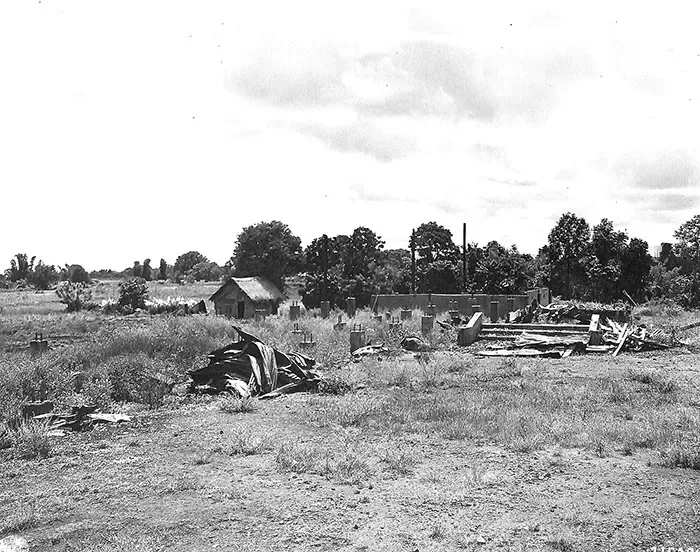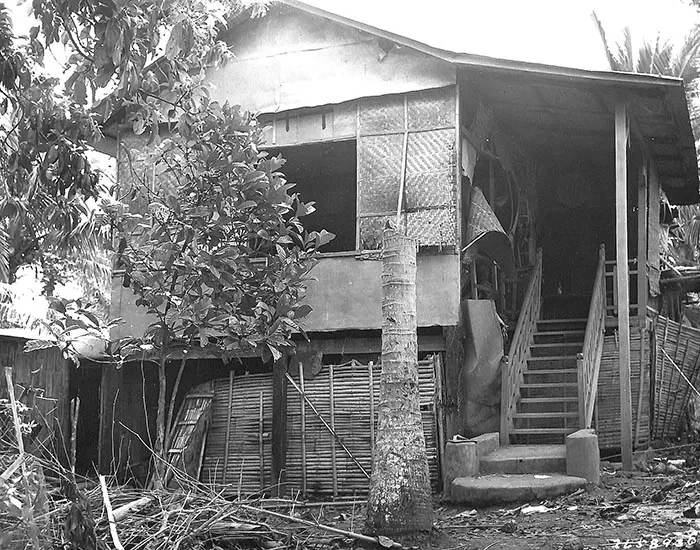Testimony of Survivor Eusebio Linatoc on the Pamintahan Massacre in Lipa, Batangas in 1945
[TRANSCRIPTION]
This page contains the testimony of Eusebio Linatoc of Lipa, Batangas on the so-called Pamintahan Massacre committed by the Japanese in the town in 1945. The pages contained herein are now declassified and were part of compiled documentation1 of war crimes trials conducted by the United States Military Commission after the conclusion of World War II. This transcription has been corrected for grammar where necessary by Batangas History, Culture and Folklore. The pagination is as it was contained in the original document for citation purposes.
 |
| Photo taken during the war crimes trials in Manila. Image credit: U.S. National Archives. |
[p. 1533]
EUSEBIO LINATOC
DIRECT EXAMINATION
(Witness so instructed by the Interpreter.)
A Eusebio Linatoc.
A In Antipolo, Lipa, Batangas.
Q How do you spell Antipolo?
A A-n-t-i-p-o-l-o.
Q Is that about two kilometers south of Lipa?
A Yes.
Q Did you live there on the 27th of February, 1945?
A In the morning, at about 6 o’clock, I was there at home.
Q What did you see in the morning at about 6 o’clock?
A The people from Aniloa [Anilao is a neighboring barrio] were going to the town accompanied by the Japanese.
Q How do you spell Aniloa?
A A-n-i-l-o-a. [This is obviously erroneous as the barrio’s name is Anilao]
Q Is that about two kilometers south of Antipolo?
[p. 1534]
Q How many people from Anilao [from this point on, Batangas History, Culture & Folklore shall use the correct spelling of the name] did you see go through Antipolo?
A I cannot give the exact number but there were so many — very many.
Q Approximately how many?
A Maybe they were around 700.
Q This happened after 6 o’clock. Did anything happen to you later in the morning?
A Nothing else, but we were asked by the Japanese to go to town —
Q What town?
A About 7 o’clock.
Q What town were you asked to go to?
A We were asked to go to the town, but we didn’t reach the town. As soon as we reached the seminary, we were asked to get inside by the Japanese.
Q To what town were you asked to go?
A In Lipa.
Q Who was asked to go to Lipa? The men of Antipolo?
A Yes.
Q Did you start to Lipa?
A We were not able to reach the town of Lipa.
Q Did you leave Antipolo to go to Lipa?
A Yes.
Q Did you proceed down the same road that you had seen the 700 men from Anilao take an hour earlier?
A Yes.
Q How close to Lipa did you get?
[p. 1535]
Q How many men of Antipolo reached that point?
A When we reached the seminary and we were asked to get inside, we were given numbers, and my number was 406.
Q Of what seminary are you speaking?
A Minor Seminary.
Seminary was marked Prosecution
Exhibit No. 250 for identifi-
cation.)
A Yes.
GENERAL REYNOLDS: There being no objection, it is accepted in evidence.
for identification was re-
ceived in evidence and so
marked.)
A 406.
Q Does that mean that 405 men from Antipolo had gone through that gate ahead of you?
A Yes.
Q And did each man receive a number?
A Yes.
Q And after you received the number 406, did some more people come in behind you?
 |
| The ruins of the Minor Seminary where the victims were first taken. Image credit: U.S. National Archives. |
[p. 1536]
Q How many men do you think then arrived at the Minor Seminary?
A Do you want to know if it is only men from Antipolo or from Anilao?
Q Antipolo.
A When I saw the number of my uncle, it was already more than 500.
Q And he was from Antipolo, too?
A Yes.
Q Did you see any of the men from Anilao, any of the 700 men from there at the seminary when you got there?
A Yes.
Q How many of them were there?
A Maybe more than 80.
Q They were 80 there out of the 700 which you had seen earlier; is that right?
A Yes.
Q What happened after you reached the seminary and were given your number?
A We were grouped by twenties; then were given cigarettes.
Q Were the groups selected numerically, the 1 through 20 made the first group and 21 through 40 the second group, and so on?
A Yes.
Q And before anything happened to your group, were the remaining men from Anilao taken from the seminary in groups of 20?
[p. 1537]
Q And then, did they start taking your people away in groups of 20?
A Yes.
Q And what time was it by the time they reached your group?
A Maybe it was about 11 o’clock.
Q 11 o’clock in the morning?
A In the morning.
Q What happened to you at 11 o’clock, then?
A We were to be taken to the town, but we didn’t reach the town. We passed by a house which was empty. We were taken inside the house and when we were all inside, the Japanese closed the doors and the windows.
Q Yes.
A When we were already locked inside, they opened the door again, and many Japanese went in and we were all tied.
Q Yes.
A When we were all tied, we were taken near the back of the river and there, we were asked to kneel.
Q How far did you go from the Minor Seminary until you were taken into this house?
A Maybe around 800 meters.
Q And is this second house you were taken to just south of the town of Lipa?
A Yes.
Q Were you searched after you went into this house?
A When we were tied, we were searched.
Q Did they take your valuables?
 |
| Most likely the same house referred to in the witness' testimony. Image credit: U.S. National Archives. |
[p. 1538]
Q Then, you said you were taken to the river. How far was that from the Antipolo-Lipa road?
A Maybe around 800 meters.
Q East of the road?
CAPTAIN PACE: East of the road?
to was marked Prosecution
Exhibit No. 251 for identi-
cation.)
A In this house, we were asked to kneel.
Q This was the house you were taken to after your hands were tied?
A Yes.
Q Is this the house at the bank of the river?
A Yes.
GENERAL REYNOLDS: There being no objection, it is accepted in evidence.
for identification was re-
ceived in evidence.)
A Yes.
Q What happened after you kneeled?
A We were taken two by two.
[p. 1539]
A To the Japanese who killed people.
Q How far were they from where you were kneeling?
A Maybe about 20 meters.
Q What happened when you were taken there?
A To the Japanese?
Q What happened when you were taken to where the Japanese were?
A We were pushed in the middle — towards the middle of twelve Japanese.
Q Yes.
A And we were bayoneted.
Q Two at a time?
A Yes.
Q Were you bayoneted?
A Yes.
Q Will you describe the place?
A On my thigh; at my back; on my hands; on my legs; on my neck; and the nape of my neck.
Q Did the bayonet go clear through your neck?
A No. It did not go through.
Q Is the bayonet wound in your neck the reason you are unable to talk loudly?
A Yes.
Q How many bayonet wounds did you receive?
A I did not count because I shudder whenever I remember.
Q How many scars do you have today?
A I did not count.
[p. 1540]
bayonet wounds was marked
Prosecution Exhibit No. 252
for identification.)
A (No response.)
Q How many?
A Fifteen.
Q Does this picture correctly show the way the back of your body looks?
A Yes.
GENERAL REYNOLDS: There being no objection, it is accepted in evidence.
for identification was re-
ceived in evidence.)
[p. 1541]
Prosecution Exhibit No. 253
for identification.)
A Yes.
GENERAL REYNOLDS: There being no objection, it is accepted in evidence.
253 for identification was
received in evidence.)
A Two.
Q What happened to you after you received the bayonet wounds?
A I did not say anything else. I pretended to be dead.
Q When the Japanese bayoneted you, what happened to you after you were bayoneted?
A They left me.
Q On top of the bank, or did you fall down the bank?
A Down.
Q When did you regain consciousness?
A I never lost consciousness.
Q What did you see when you got to the bottom of the bank? Anything?
A Dead people.
Q Approximately how many dead people were down there?
A So many.
[p. 1542]
A When I left, may be it was 1000.
Q Did you see people there from Anilao?
A Alive?
Q No; dead/
A No.
Q Were all the people you saw from Antipolo?
A From Anilao and Antipolo.
Q The people you saw dead were from both Anilao and Antipolo?
A Yes.
Q Were they in the two groups which you had referred to earlier, one the group of 700 people from Anilao and the group of over 406 from Antipolo?
A Yes.
Q How were they wounded, do you know?
A I did not see.
Q Were they all dead?
A Yes.
Q Did they have blood on them?
A I did not see.
Q Did you see any blood on he dead people?
A Yes.
Q Do you know if anybody survived from Anilao?
A Yes.
Q How many?
A One.
Q Out of the 700?
A Yes.
[p. 1543]
GENERAL REYNOLDS: It is a sound objection. The Prosecution is cautioned to make the point clear.
CAPTAIN PACE: I beg your pardon, sir?
GENERAL REYNOLDS: The objection by Counsel is sound, and the witness has been most indefinite about the numbers and did make it very clear it was an estimate, and Prosecution should be governed accordingly.
A Civilians.
Q How many people from Antipolo survived?
A 13
THE INTERPRETER: Only 3; correction.
A (Through the Interpreter) Yes.
Q What happened to the other two?
A They are alive.
Q Were they wounded?
A Yes.
Prosecution Exhibit No. 254
for identification.)
[p. 1544]
A Yes.
Q What is it?
A This is the place where we were killed — this is the place of the killing, and this is the person that has been saved. His name is Santo Batista. [The name of this same person in a file photograph at the U.S. National Archives was given as Santos Bautista.]
Q Was this survivor standing there, standing approximately where you were when you were bayoneted?
A Yes.
GENERAL REYNOLDS: There being no objection, it is accepted in evidence.)
(Prosecution Exhibit No. 254
for identification was
received in evidence.)
(A photograph was marked
Prosecution Exhibit No. 255
for identification.)
A These are the skulls of the persons who were killed and who were our companions.
Q Is that all of them, or just part of them?
A This is not all.
GENERAL REYNOLDS: There being no objection, it is accepted in evidence.
for identification was
received in evidence.)
[p. 1545]
(Short recess.)
GENERAL REYNOLDS: The Commission is in session. Proceed.
CAPTAIN REEL: Just one or two questions.
CROSS-EXAMINATION
A (Through the Interpreter) No.
Q Do you know whether any of the others were guerrillas?
A No.
Q You don’t know?
A I don’t know.
CAPTAIN PACE: Thank you very much.


